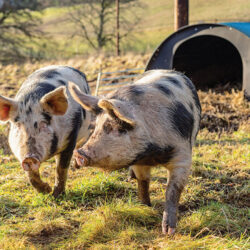
Features
Animal Health
A primer on African swine fever
By Jack Kazmierski
Diligence with feed can be a strong defense
 A 3D illustration of the African Swine Fever virus, which is said to have a 100 per cent lethality rate among pigs
Photo: © Dr_Microbe / Adobe Stock
A 3D illustration of the African Swine Fever virus, which is said to have a 100 per cent lethality rate among pigs
Photo: © Dr_Microbe / Adobe Stock The African swine fever virus (ASFV) has been infecting wild pigs for hundreds of years, according to Declan C Schroeder, PhD, molecular virology and associate professor, veterinary population medicine at the University of Minnesota.
Schroeder explains that ASFV originated with pig populations in Africa (hence the name of the virus), and that the current outbreak is affecting regions in Asia and Europe. The virus has never made its way to North America, and currently (as of press time), there are no known cases of ASFV in Canada or the U.S.
However, the fact that it has spread to nearby countries as close as Haiti and the Dominican Republic, and as recently as 2021, is reason enough for some pork producers in North America to on high alert. Elsewhere, some countries that have not yet had confirmed cases of ASFV themselves, but have witnessed outbreaks in neighbouring countries, have begun taking an educational approach; for example, while there have not yet been cases of ASFV in the U.K., following the confirmation of the virus in Italy, Stewart Houston, pig sector chairman of the not-for-profit U.K. farming assurance scheme Red Tractor published a blog post urging the country’s swine farmers to be vigilant and step up biosecurity efforts and smart feed practices.
Only managed by culling
This virus is lethal. In short, infection leads to organ failure, and there’s not way to treat infected pigs. “When it gets into animals, it’s 100 per cent death,” adds Schroeder. “It’s hard to control, so essentially, the only way we manage it is by culling.” When the virus hit China in 2018, Schroeder says that more than 60 per cent of the country’s pig population had to be destroyed.
Scientists are working on a vaccine for pigs, but it’s still in the trial phase. “They’re testing vaccines in Vietnam, and there are a few large-scale trials taking place, but in terms of a cure, we’re still in the early days of a vaccine,” explains Schroeder.
Mitigation strategies are available, and there are chemicals that can be used to clean up a facility after an outbreak, but there’s nothing to mitigate an outbreak once an animal is infected.
A robust adversary
ASFV is exceptionally robust and measures that would normally kill some other viruses have proven to be ineffective when attempts have been made to destroy ASFV. The University of Minnesota recently reported that the virus is able to survive temperatures up to 100 degrees Celsius (212 degrees Fahrenheit), which is the temperature at which water boils, for extended periods of time.
“If you boil something for 20 minutes, you would think that would kill it,” adds Schroeder, “But actually, when it comes to this virus, its structure is maintained. And that has completely surprised us. We weren’t expecting that. It was assumed that at that temperature, everything would have dissolved, but that didn’t happen with this virus.”
How ASFV spreads
The good news is that ASFV does not spread easily by air. If it did, then, like SARS-CoV-2, it would be able to spread rapidly. That said, ASFV could make its way into North America in a variety of ways, and precautions must be taken surrounding the import of feed, as well as travel (note: also unlike SARS-CoV-2, ASFV does not affect humans).

The Canadian Food Inspection Agency (CFIA) counts feed monitoring among key biosecurity steps to protect against ASFV
Photo: Canadian Food Inspection Agency
In his blog post, Houston outlined how ASFV could potentially spread, including “movement of infected live animals, contaminated equipment, or infectious products,” as well as farm workers who might have travelled abroad.
Houston added the following advice: “An important precaution is to ensure that all visitors and farm workers are using dedicated clothing and boots when entering pig premises, and that any vehicles and equipment entering the premises are cleaned and disinfected before and after. If you employ seasonal or workers from abroad, it’s important that they are able to read the biosecurity protocols, which may mean making them available in other languages. It is also crucial to ensure that people who look after or visit your pigs understand the disease risk of bringing back meat products, particularly wild boar meat or pork products, from affected countries.”
“Humans are the culprit,” adds Schroeder. “This virus is really stable in meat, so if we bring in food from a country that’s infected, then that’s one of the most likely ways the virus would make it to North America. That’s why there are signs at airports telling people not to bring in meat.”
The feed factor
A major risk for pork producers is feed.
Just like food imported for human consumption, pig feed can carry ASFV, spreading the virus to new populations of pigs. “We import feed and ingredients that go into feed from ASFV-infected countries,” adds Schroeder. “One of the papers I published shows that if this virus was in feed, it would survive a trip around the U.S. because ASFV can survive in feed for 23 days without any degradation of the virus.”
The fact that ASFV is so resilient, and so difficult to destroy, suggests that extra vigilance may be required on top of current Canadian and U.S. biosecurity protocols. For example, the Canadian Food Inspection Agency (CFIA) recommends holding feed ingredients in storage prior to feeding in order to reduce viral survival. Although that’s good advice, the CFIA quotes the following guidelines from the Canadian Pork Council (CPC): hold feed ingredients “at a temperature of 20 degrees Celsius for 20 days or 10 degrees Celsius for 100 days.”
However, Schroeder’s research suggests that the virus can survive 100 degrees Celsius for 20 minutes, and that it can survive in feed for up to 23 days. That said, Schroeder is quick to point out that we still don’t have all the answers, and that more research needs to be done in order to determine what kind of viral load would be needed in order to infect a new host through feed. We just don’t have those answers at the moment.
In the meantime, before we find answers to all the unknowns, the CFIA is warning pork producers to buy feed only from trusted sources that have proper biosecurity measure in place.
“Producers and feed manufacturers who purchase ingredients to produce pig feed should know the origin of the ingredients,” the CFIA warned in a recent advisory. “Producers and feed importers should verify that feed ingredients were produced and handled using proper biosecurity measures. Feed importers should be able to provide feed purchasers with information on how the ingredients were produced and handled before entry into Canada.”
Vigilance, not panic
With a 100 per cent fatality rate, ASFV can have a devastating impact on pig populations, which in turn translates into a significant economic loss. Even if ASFV were to be detected in only a small number of animals within a herd, the entire population would have to be culled in order to prevent the spread of the disease.
“The impact would be huge,” explains Schroeder, “Because it will affect everything, including local production, as well as our ability to export, and we export a lot.”
In addition, all the industries that support pork producers would be impacted. Moreover, an ASFV outbreak could lead to food shortages on a more global scale. “As you know, 40 per cent of the world still eats pork as a protein source,” adds Schroeder. “So you’d have to consider if we could supply the world’s protein if we had to cull a large number of our pigs.”
While the idea of ASFV infecting pigs in North America is frightening, there’s no reason for alarm at this point in time. Pork producers need to be vigilant, and as Schroeder concludes, we can be thankful that the virus has never been a problem on our continent, and that it would be difficult for it to spread.
“To be fair,” concludes Schroeder, “Our virus security in North America is pretty good, which is probably the reason we haven’t seen ASFV here yet. The good news is that this is not readily spread via aerosols, and although it can spread through ticks, it’s not the species of ticks we have here in North America. So, although more research is needed, and we need to remain vigilant, there’s no reason to panic.”
Print this page